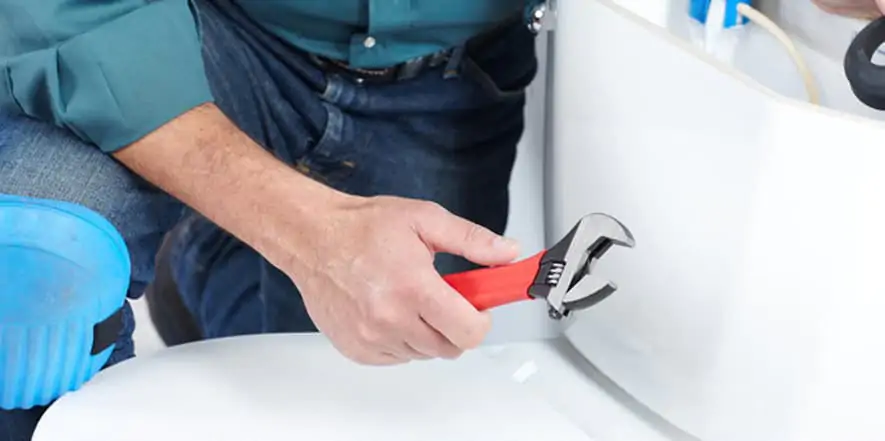There’s nothing quite like that sinking feeling when you amble over to the porcelain throne, ready to resume your rightful spot on the reading material, only to discover a bone-dry wasteland where your trusty toilet bowl’s water reservoir should be. No tranquil water levels glistening beneath the tank lid, patiently awaiting your next flush endeavor. Just…emptiness.
Before splashing out on an entirely new commode or submitting to visions of endlessly heaving buckets to refill the void, take a deep breath. While a waterless toilet tank may seem catastrophic, it’s usually just a minor hiccup stemming from one of a few common technical difficulties. From faulty valve mechanisms to clogged supply lines, these are problems any mildly handy homeowner can potentially diagnose and remedy themselves.
But skills (and situations) may vary, so knowing when to call in professional plumbing backup is key. Allow us to guide you through pinpointing that tank dryness culprit – be it a DIY fix or necessitating the pros. Your days of greeting an unwelcoming waterless toilet chasm are numbered!

Common Causes of a Dry Toilet Tank
That unexpectedly parched toilet tank staring back at you could stem from any number of easily remedied issues. Before embarking on a full-blown panic, let’s dive into the most frequent culprits leaving your porcelain bowl high and dry. Understanding these common causes is the first step toward getting that water reservoir refilled and restoring your toilet’s flushing capabilities.
Malfunctioning Float Mechanism
One of the most frequent bathroom gremlins responsible for draining toilet tank water reserves is a failure of the critical float mechanism. This unassuming device monitors water levels and controls the intake supply to automatically keep the tank topped up after each flush.
The float itself is essentially a hollow ballast attached to a vertical trip rod or calibrated lever system. As the tank empties during flushes, the buoyant float descends until reaching a low level that triggers the intake valve opening – allowing water to stream back in and refill the tank. Once those desired water heights return, the rising float shuts off the intake valve at a preset shutoff point.
But if that float runs into issues like cracks leaking air and causing it to sink prematurely, or the lever apparatus becomes obstructed or unhinged, it prevents the normal intake cycling process. The result is the tank not automatically refilling like usual after flush draining.
Faulty Fill Valve
While the float mechanism acts as the water monitor, it’s the toilet’s fill valve component that physically controls the intake flow based on those level readings. Even if the float is in proper working condition, any malfunctions in this valve mechanism itself can just as easily prevent tank refilling.
Constructed from basic plumbing hardware like washers, seals, and spring-loaded diaphragms, fill valves eventually wear out over years of continual opening/closing usage. As valve inlets corrode or rubber gaskets stiffen with age, water cannot pass through to recharge the tank’s reserves. Cracks in valve bodies short-circuit the entire intake system. Mineral buildup creates friction obstructions preventing levers from actuating properly.
In worst-case scenarios with total fill valve failure, your toilet tank becomes little more than a waterless void – all because this crucial refilling gizmo is preventing intake regardless of what the float mechanism signals. Life expectancies of fill valves tend to be around 3-5 years before these components start displaying telltale issues.
Water Supply Issues
Even if your toilet’s interior fill valve and float mechanisms are functioning perfectly, a lack of water actually being supplied to the tank can still leave you high and dry. Anything disrupting the flow through that flexible supply line is a potential culprit.
Low municipal water pressure is one potential supply issue that could be restricting intake quantities. If pressure drops too low, there simply isn’t enough hydraulic force to adequately recharge tank levels after each flush cycle. Mineral buildup inside aging pipes creates friction that compounds low pressure problems.
Supply line obstructions like kinks, clogs, or outright leaks lower that critical pressure even further. Those bendable supply hoses aren’t impervious to eventually springing cracks or having debris sneak inside to interfere with smooth water transmission. Crimped lines restrict flow, while severe leaks drain away any supply entirely.
Failing to fully reopen the supply line’s shut-off valve all the way after maintenance can also create a bottleneck – only a tiny trickle making it through. Any supply problems upstream feed a downstream empty tank.
Damaged or Misaligned Trip Assembly
Your toilet’s water refilling process relies on an unassuming but essential trip assembly to actually trigger the flush cycle and drain the tank. Any damage or dislocation to this intricate lift mechanism can prevent it from properly activating.
Consisting of a handle lever connected to a lift chain or rod, this innocuous assembly simultaneously raises the tank’s drain flapper while opening the flush valve to allow the released water to rapidly enter the bowl. In one smooth motion, the entire tank payload evacuates when the trip pulls this drain seal.
But any obstructions, rust buildup, or general wear across the trip’s swing arc can hamper these synchronized mechanics from working as designed. Bent components, broken chains, or getting the geometry misaligned all prevent that critical drain sequence from finishing. Your tank stays stagnantly full rather than flushing.
While often overlooked, these deceptively straightforward trip assemblies play an essential role in siphoning tank water. Damage disrupts that siphoning process, leaving tanks full with nowhere for that water to purposefully evacuate.
Leaks or Cracks in the Tank
An insidious reason why your toilet tank may have suspiciously drained itself relates to compromised structural integrity. Cracks, splits, or just general porousness in the tank’s exterior can allow water to slowly seep out over time.
Toilet tanks endure constant heating and cooling cycles from the constant intake of fresh water refills mixing with lingering stagnant temperatures. This thermal stress, combined with pressure from the water weight itself, can fatigue and weaken tank materials until microscopic fractures form.
From there, it’s only a matter of time before those hairline cracks propagate into larger breaches – allowing the entire tank’s water reserves to hemorrhage out in a steady trickle or gushing deluge. Porcelain and ceramic tanks tend to be most vulnerable to this type of degradation over many years.
While potentially not an immediate cause for panic, any moisture seeping from the tank itself constitutes an irreparable hardware failure requiring a full tank replacement before the leaking situation worsens.
Blocked or Faulty Overflow Tube
Nestled alongside the main tank interior, that unassuming pipe is actually playing a crucial overflow contingency role – acting as an emergency drainage route should the main water intake ever exceed the tank’s maximum capacity.
By providing this always-open alternate passage directly into the toilet bowl, any accidental overfilling incidents can safely discharge excess water downward rather than allowing the tank to overpressurize and potentially rupture.
However, if this overflow tube becomes blocked, obstructed, or develops internal cracks of its own, it eliminates that crucial redundant safety drainage path. Without this emergency overflow option, the ascending water levels could rapidly fill the main tank beyond its designed thresholds until it starts trickling out of any existing seams, cracks, or the main drain opening itself.
While clearly not operating as an intake mechanism, a compromised overflow tube nevertheless represents a potential root cause for your tank’s disappearing water act. Until the inevitable spill-over point evacuates the entire tank prematurely – leaving you with a strikingly opposite but equally concerning high water scenario to address.
Improperly Sealed or Worn Flapper Valve
Located at the base of the tank, this often overlooked rubber flapper valve plays a pivotal role in containing your toilet’s water supply until flush time. Acting as the tank’s drain seal, it creates an airtight barrier when closed to block water from prematurely evacuating down into the bowl.
However, if this flapper develops cracks, warps out of shape, or simply wears out over years of repeated opening/closing cycles, that all-important seal gets compromised. Seemingly innocuous hairline separations around the edges allow water to steadily seep through the opening rather than remaining locked in the tank.
Mineral deposits caked onto the flapper’s underside can also prevent it from creating that reliable airtight seal when in the closed position. Even with the slightest of openings present, basic physics dictates your tank’s entire water payload will drain in a continuous steady stream until the reservoir hits empty.
Failure to seat these flappers properly after installation or maintenance can create similar premature discharge problems. An improperly aligned or shifted flapper means constant water wastage until it’s seated and sealed correctly.
Clogged Toilet Vents
While not an intake component preventing your tank from refilling, clogged toilet vents can create systemic vacuum pressures that inadvertently siphon away tank reserves through the bowl. These critical vent pipes enable crucial airflow replacement to facilitate smooth drainage during flushes.
If these vents become obstructed or blocked by leaves, debris, ice dams, or even invasive critters, it disrupts that smooth airflow dynamic underpinning your toilet’s flush cycle. Without that steady air replacement to equalize pressures, an airtight environment forms that relentlessly tries sucking every ounce of fluid down – including the entire tank’s water supply.
While not the root cause itself, blocked vents exacerbate premature drainage situations while also impairing drainage efficiency in general. Left unresolved, the resulting vacuum extremes could even start pulling water out from sink drains or bathtub lines connected to the same ventilation system.
While each of these represents a common reason your toilet tank may have unexpectedly drained, don’t assume the fix is a simple DIY project just yet. Certain causes may lead to lasting damage requiring more in-depth repairs or even replacements that exceed the average homeowner’s skills. We’ll explore when to wave the white flag and call in professional plumbing backup in the next section. But first, get acquainted with systematically troubleshooting and pinpointing the source of your tank’s water woes.
Troubleshooting Common Causes
With those common culprits for a dry toilet tank identified, it’s time for some hands-on forensic investigation to pinpoint the exact source and implement a fix. Simply diagnosing the potential cause only gets you partway to resolution.
Malfunctioning Float Mechanism
For a faulty float causing refill issues, check for any visible cracks allowing air leakage that would weigh it down prematurely. The float should remain buoyant when submerged. If not, replacement is required. Also inspect the float’s lever assembly for any obstructions, mineral buildup, or detached components preventing it from activating the fill valve properly.
Faulty Fill Valve
Bypass the float entirely and operate the fill valve manually to isolate its function. If no water passes through when activated, the valve is likely obstructed or its internal seal has failed. Disassemble and clean thoroughly, replacing any deteriorated gaskets or washers. For solid valve bodies, complete fill valve replacement is recommended.
Water Supply Issues
Start by checking incoming water pressure at the supply line with a basic gauge. Low pressure may indicate larger plumbing issues requiring a pressure regulator installation or re-piping. Assuming normal pressure, inspect the supply line for kinks, clogs, or leaks that could prevent flow. Use a plumber’s snake or air compressor to clear blockages.
Damaged/Misaligned Trip Assembly
The trip lever that activates the flush cycle can wear out over time or get knocked out of alignment. Check for any visible damage, disconnected chains, rust buildup, or improper geometries that prevent the lift motion from properly cycling the flush. Realigning or replacing damaged components should restore proper draining.
Leaks/Cracks in the Tank
Unfortunately, any crack or fracture in the toilet tank itself that allows water to visibly leak requires complete tank replacement. Over time, tanks develop hairline splits due to temperature fluctuations and pressure stresses. Don’t risk a catastrophic failure – swap out cracked tanks immediately.
Blocked/Faulty Overflow Tube
Clear the overflow tube of any obstructions using a straightened coat hanger or plumber’s auger. Note any cracks that would require a tube replacement. The overflow serves as an emergency drainage route, so it’s critical to keep it clear.
Worn Flapper Valve
Inspect the drain flapper’s rubber seal for any warping, mineral buildup, or deterioration preventing an airtight seal from forming. Clean off deposits and plunge the flush a few times to try reseating it properly. If valve integrity is too compromised, replace the flapper valve entirely.
Clogged Vents
For drainage issues caused by blocked air vents, use a plumber’s auger to clear any obstructions in the vent pipes feeding into your toilet’s drain line. Consult an HVAC pro if you suspect widespread household vent system clogs.
With some hands-on troubleshooting aimed at the root cause, you’ll soon have that formerly dry toilet tank refilled and your bathroom’s crowning porcelain throne oasis restored! Don’t hesitate to consult a professional plumber for particularly stubborn cases.
When to Call a Plumber
You’re now equipped with a full toilet tank troubleshooting arsenal – from diagnosing faulty fill valves and dodgy drain seals to hunting down dastardly supply line obstructions. With some elbow grease, many common culprits are within the realm of DIY resolution.
However, even the handiest homeowners must learn to recognize their own limitations before finding themselves in too deep. While basic toilet repairs seem approachable, certain complications quickly escalate beyond amateur abilities.
When to Wave the White Flag
Any severe water damage from cracks or leaks beyond just the toilet warrants an immediate professional plumbing SOS. Saturated floors harboring moisture intrusion open a bevy of structural threats like rot, mold, and deterioration that are best left to the pros.
Signs of systemic air pressure or ventilation blockages causing drainage issues across multiple fixtures also hit a DIY ceiling. While unclogging isolated toilet stacks is feasible, widespread obstructions require experienced plumbers and specialized equipment.
And despite toilet components seeming amateur-friendly, unfamiliarity with intricate flush dynamics risks creating hilarious accidental geysers and siphoning spectacles. Nobody wants an avant-garde bathroom art installation against their will.
The Pro Advantages
Beyond jobs exceeding DIY skills, plumbers offer distinct advantages even for straightforward repairs – starting with expediency. What may consume frustrating weekends troubleshooting, experienced pros diagnose and remedy in hours thanks to specialized tools and system mastery.
Many also warrant their toilet repair workmanship to prevent repetitive band-aiding. And conscientious plumbers optimize entire systems – specifying high-efficiency replacements, ensuring proper ventilation, and scoping drain lines for any lingering issues.
So attempt any comfortable remedies, but know when to elevate to those with the big repair guns. A trustworthy plumbing pro has the expertise and artillery to fix even the most stubbornly drained and dehydrated throne.
Get Your Porcelain Throne Rehydrated with Gene Johnson Plumbing
Whether drained by a faulty flapper or a clogged vent, that waterless toilet tank isn’t refilling itself. Resolving the underlying cause is crucial for restoring your bathroom’s flushing capabilities.
This guide equipped you with techniques to troubleshoot common culprits like fill valve issues and supply line obstructions. You now know when to DIY versus calling professional reinforcements.
But not every homeowner has the tools or tenacity to resurrect a drained toilet through DIY efforts alone. That’s where the trusted experts at Gene Johnson provide our seasoned mastery.
Our technicians leverage inspection technology and decades of experience to quickly diagnose and rectify even the most perplexing cases leaving your porcelain throne barren. We offer comprehensive toilet repair and installation.
Don’t settle for temporary half-measures that allow issues to resurface. Seek a permanent resolution by calling (206) 792-7495. With our intervention, you’ll soon be reunited with a properly rehydrated, flushing throne.





